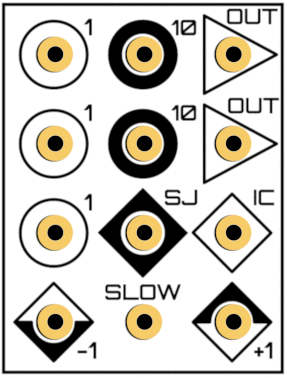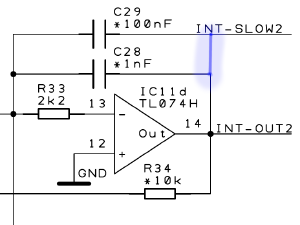Difference between revisions of "Integrator"
| Line 26: | Line 26: | ||
See also [[XIR]]. | See also [[XIR]]. | ||
| − | == Mathematics about analog integration == | + | == Mathematics and Electronics about analog integration == |
| + | On an electronical level, Integrators work quite similar to [[Summer]]s (and [[Inverter]]s, respectively), given the closed-loop operational amplifier setup. However, they feature a capacitor in the feedback channel which holds the current integration level. This makes an integrator ''stateful'' in contrast to the ''stateless'' Summers. | ||
| + | |||
| + | In the [[THAT]] circuits, you find the integrators on page [[:File:Anathing_v1.0_base_3.pdf]]. As you can see there, they are implemented with ICs called <code>TH074H</code>. See [https://www.ti.com/lit/ds/symlink/tl074h.pdf?ts=1628761245896&ref_url=https%253A%252F%252Fwww.ti.com%252Fproduct%252FTL074H] for the datasheet of this chip. | ||
| + | |||
| + | {{todo|write more}} | ||
| − | |||
[[Category:Components of The Analog Thing]] | [[Category:Components of The Analog Thing]] | ||
Revision as of 12:36, 12 August 2021
Integrators are the essential building blocks of analog computers. They perform integration in time, as in c = integral_0^t integrand(t') dt'. The Analog Thing features five integrators. This allows computing five integrals in a program.
Electronic analog computers typically perform integration by charging and discharging capacitors. The key difference between an integrator and a summer is the capacity in the feedback channel instead of a simple resistance. Accordingly, all integrators are also summing their inputs. For more details, please refer to Analog computing literature.
Basic Usage of an Integrator on The Analog Thing
- Circles represent inputs, triangles represent outputs
- Analog integrators sum their inputs. That is, if you have a sum under your integral, you can save a single summer before the integrator. Otherwise, just put your integrand into the upper left input labeled with
1. - There are two output slots. Just use one of them as you like.
- The
ICslot stands for initial conditions. It is an input where you have to provide suitable initial conditions. As shorthands,-1and+1are right to the hand. If this slot is left empty,0is taken as initial condition. - Beginners may ignore the slots
SJandSLOW.
![]() Attention: Make sure the sum of your inputs does not exceed the machine unit (±10V), otherwise an overload will occur (indicated by the OL LED)
Attention: Make sure the sum of your inputs does not exceed the machine unit (±10V), otherwise an overload will occur (indicated by the OL LED) ![]() . See Logic levels for details.
. See Logic levels for details.
Extended Usage of an Integrator
Changing the integration speed
You can change the integration time scale factor k0 of a particular integrator by connecting SLOW to OUT. This effectively decreases the k0 by factor 100. The circuit on the right was taken from File:Anathing v1.0 base 3.pdf.
Making use of the Summing junction
See also XIR.
Mathematics and Electronics about analog integration
On an electronical level, Integrators work quite similar to Summers (and Inverters, respectively), given the closed-loop operational amplifier setup. However, they feature a capacitor in the feedback channel which holds the current integration level. This makes an integrator stateful in contrast to the stateless Summers.
In the THAT circuits, you find the integrators on page File:Anathing_v1.0_base_3.pdf. As you can see there, they are implemented with ICs called TH074H. See [1] for the datasheet of this chip.

